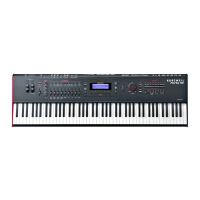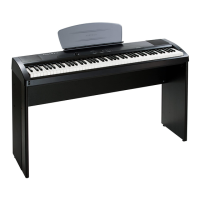The Effects Chain Editor
Effects Parameters
4-17
Tap Pan sets the stereo position for a given tap’s output. e range is -100% for fully left, to
100% for fully right.
Atk Time (attack time) is the time for the gate to ramp from closed to open (reverse if
Ducking is on) after the signal rises above threshold, adjustable from 0.0 to 228.0 ms.
Rel Time (release time) is the time for the gate to ramp from open to closed (reverse if
Ducking is on) after the gate timer has elapsed, adjustable from 0 to 3000 ms.
LFO Rate sets the speed of modulation of the delay lines with a range of 0.01 to 10 Hz.
LFO Dpth sets the maximum detuning depth of the LFO-modulated delay lines, with a
range from 0 to 50 cents (= 1/2 semitone).
Tap Dly adds extra delay in front of the LFO modulated delay taps from 0 to 230 ms.
L/R Phase or LFOn LRPhs adjusts the relative phases of the LFOs for the left and right
channels in the stereo Choruses.
Flanger
Flanging is the process of adding or subtracting a signal with a time-displaced replica of itself,
which results in a series of notches in the frequency spectrum, generally referred to as a comb
lter. In the PC4, the anger is a multi-tap delay line, all (but one) of whose taps can have
their lengths modulated up and down by a low frequency oscillator (LFO). e rate of the
LFO is expressed in Tempo.
StatDlyLvl (Static Delay Level) is the level of the rst, non-moving tap. Negative values
invert the polarity of the tap. e range is -100 to 100%; 0% turns the tap o.
DlyCrs and DlyFin are the coarse and ne length controls for the Static delay (StatDly...)
and for the minimum value of the moving delays (Dlyn...). e coarse range is 0 to 228 ms,
and the ne range adjusts the coarse range in samples (= 1/48,000 sec = 20.8μsec) from -127
to 127.
Xcurs Crs and Xcurs Fin determine how far the LFO-modulated delay taps can move from
the center of their ranges. e total range of the LFO sweep is twice the excursion. If the
excursion is set to 0, the LFO does not move and the tap behaves like a simple delay line set
to the minimum delay. e coarse range is 0 to 228 ms; the range 0 to 5 ms is most eective
for anging. e ne range adjusts the coarse range in samples from -127 to 127.
Quantize
is eect produces digital distortion known as quantization noise, by limiting the number
of bits available to the signal. See eect 329 “Aliaser.”

